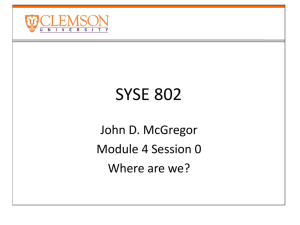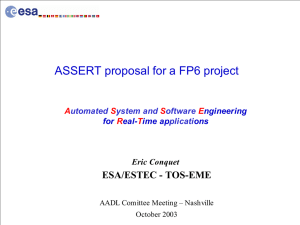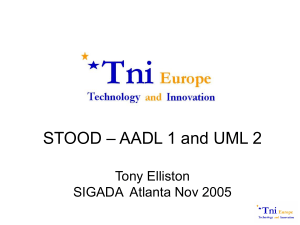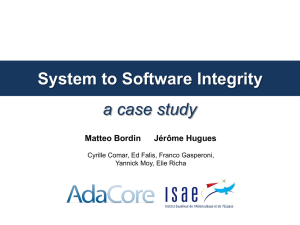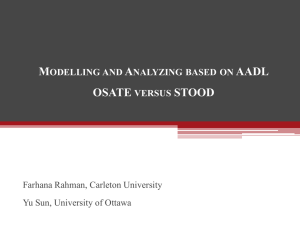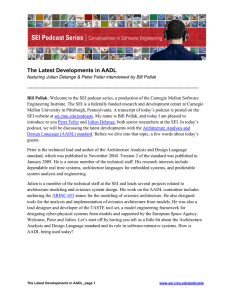Architecture Modeling and Analysis for Embedded Systems
advertisement
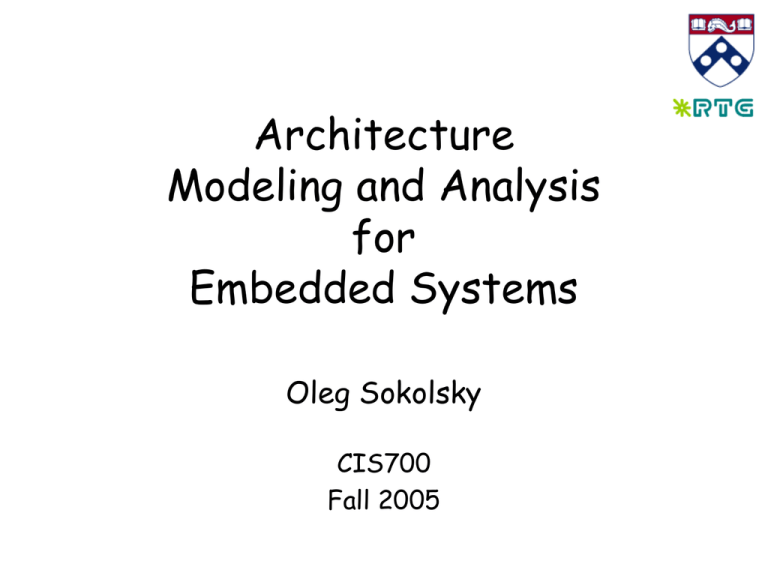
Architecture Modeling and Analysis for Embedded Systems Oleg Sokolsky CIS700 Fall 2005 Overview • Background – Architecture description languages – Embedded and real-time systems • AADL: ADL for embedded systems • Analysis of embedded systems with AADL 9/19/2005 Architecture modeling with AADL 2 of 40 Architecture vs. behavior • How it is constructed vs. what does it do? • Traditionally, behavior was considered more important 9/19/2005 Architecture modeling with AADL 3 of 40 Software and hardware architectures • Software architecture: – fundamental organization of a system, embodied in its components, – their relationships to each other and the environment, and – principles governing its design and evolution • Hardware architecture: – Interfaces for attaching devices – Instruction set architecture 9/19/2005 Architecture modeling with AADL 4 of 40 Components, ports, and connections • Components are boxes with interfaces • Component interfaces described by ports: – Control – Data – Resources • Connections establish control and data flows • The nature of components may be abstracted – Hardware or software, or hybrid 9/19/2005 Architecture modeling with AADL 5 of 40 Software ADLs • Wright – Connector-based: CSP connector semantics – Configuration and evolution support • ACME – Interchange format: weak semantics or constraint enforcement, little analysis • MetaH – Strong component semantics – Specification of non-functional properties 9/19/2005 Architecture modeling with AADL 6 of 40 Overview • Background – Architecture description languages – Embedded and real-time systems • AADL: ADL for real-time systems • Analysis of embedded systems with AADL 9/19/2005 Architecture modeling with AADL 7 of 40 Embedded system architectures • Both hardware and software aspects are important – Increasingly distributed and heterogeneous • Tight resource and timing constraints • Multimodal behaviors – Some components are active only in certain circumstances • E.g., fault recovery • Analysis is important 9/19/2005 Architecture modeling with AADL 8 of 40 Real-time systems • The science of system development under resource and timing constraints – System is partitioned into a set of communicating tasks – Tasks communicate with sensors, other tasks, and actuators • Impose precedence constraints s s s 9/19/2005 Task 1 Task 2 Task 3 a Task 4 Architecture modeling with AADL a 9 of 40 Task execution • Tasks are invoked periodically or by events – Must complete by a deadline • Tasks are mapped to processors • Tasks compete for shared resources – Resource contention can violate timing constraints invoke dormant running complete blocked 9/19/2005 preempted Architecture modeling with AADL invoked 10 of 40 Real-time scheduling • Processor scheduling – Task execution is preemptable – Tasks assigned to the same processor are selected according to priorities – Priorities are assigned to satisfy deadlines • Static or dynamic • Resource scheduling – Mutual exclusion • Often non-preemptable – Correlated with processor scheduling 9/19/2005 Architecture modeling with AADL 11 of 40 Overview • Background – Architecture description languages – Embedded and real-time systems • AADL: ADL for real-time systems • Analysis of embedded systems with AADL 9/19/2005 Architecture modeling with AADL 12 of 40 AADL highlights • Architecture Analysis and Design Language • Oriented towards modeling embedded and realtime systems – Hardware and software components – Control, data, and access connections • Formal execution semantics in terms of hybrid automata • SAE standard AS-5506 9/19/2005 Architecture modeling with AADL 13 of 40 AADL components Software components Platform components • Thread • Processor thread • Thread group • Data processor • Memory thread group memory • Bus data • Subprogram • Device subroutine • Process process bus device System components • System System 9/19/2005 Architecture modeling with AADL 14 of 40 Component interfaces (types) • Features – Points for external connections • E.g., data ports • Flows – End-to-end internal connections • Properties – Attributes useful for analysis 9/19/2005 Architecture modeling with AADL 15 of 40 Component implementations • Internal structure of the component – Subcomponents are type references – Connections conform with flows in the type – External features conform with the type – Internal features conform with subcomponent types 9/19/2005 Architecture modeling with AADL 16 of 40 Features and connections • Communication – Ports and port groups – Port connections • Resource access – Required and provided access – Access connections • Control – Subprogram features – Parameter connections 9/19/2005 Architecture modeling with AADL 17 of 40 Ports and port groups • Ports are typed – Data component types • Ports are directional – Input, output, or bi-directional • Synchronous or asynchronous communication – Event, data, or event data ports • Input event and event data ports have queues • Input data ports have status flags for new data 9/19/2005 Architecture modeling with AADL 18 of 40 Data components • Data component types represent data types • Data component type can have subprogram features that represent access methods • Data component implementations can have data subcomponents that represent internal data of an object • Data component types can also be used as types of data ports and connections 9/19/2005 Architecture modeling with AADL 19 of 40 Thread components • Thread represents a sequential flow of control – Can have only data as subcomponents • Threads are executable components – Execution goes through a number of states • Active or inactive – Behaviors are specified by hybrid automata 9/19/2005 Architecture modeling with AADL 20 of 40 Thread states Uninitialized Thread Initialize Active Member of current mode InitializeComplete: Inactive Not member of current mode Initialized Thread InactiveInInitMode: Activate ActiveIn NewMode: ActiveInInitMode: ActivateComplete: Active Dispatch: Suspended Complete: Inactive Compute Fault: Repaired: Recovered: Recover DeactivateComplete: Deactivate InactiveInNewMode: Terminate: Thread State Thread State with Source Code Execution 9/19/2005 Finalize FinalizeComplete: Terminated Thread Architecture modeling with AADL 21 of 40 Thread Hybrid Automata 9/19/2005 Architecture modeling with AADL 22 of 40 Thread properties • Dispatch protocol – periodic, aperiodic, sporadic, or background • Period – For periodic and sporadic threads • Execution time range and deadline – for all execution states separately (initialize, compute, activate, etc.) 9/19/2005 Architecture modeling with AADL 23 of 40 Thread dispatch • Periodic threads are dispatched periodically – Event arrivals are queued • Non-periodic threads are dispatched by incoming events • Pre-declared ports – Event in port Dispatch • If connected, all other events are queued – Event out port Complete 100ms • Can implement precedence 9/19/2005 Architecture modeling with AADL T1 Dispatch Complete T2 24 of 40 Subprograms • Data subprograms are features of data components • Server subprograms are features of threads • Represent entry points in executable code • No static data – External data access through parameter and access connections • Data subprograms are called within a process • Server subprograms are called remotely 9/19/2005 Architecture modeling with AADL 25 of 40 Other software components • Process – Represents virtual address space – Provides memory protection • Thread group – Organization of threads within a process – Can be recursive • Subprogram – Represents entry points in executable code – Calls can be local or remote 9/19/2005 Architecture modeling with AADL 26 of 40 Platform components • Processor – Abstraction of scheduling and execution – May contain memory subcomponents – Scheduling protocol, context switch times • Memory – Size, memory protocol, access times • Bus – Latency, bandwidth, message size 9/19/2005 Architecture modeling with AADL 27 of 40 Port connections revisited • Event connections support n-n connectivity • Data connection support 1-n connectivity – One incoming, multiple outgoing 9/19/2005 Architecture modeling with AADL 28 of 40 Port connections revisited • Semantic port connection – Ultimate source to ultimate destination • Thread, processor, or device • Type checking of connections – Directions and types must match 9/19/2005 Architecture modeling with AADL 29 of 40 Immediate and delayed connections • Data connections between periodic threads 10ms T1 10ms 10ms T2 T1 T1 T1 T2 T2 9/19/2005 Architecture modeling with AADL 10ms T2 30 of 40 Component bindings • Software components are bound to platform components • Binding mechanism: – Properties specify allowed and actual bindings • Allows for exploration of design alternatives data thread processor 9/19/2005 bus Architecture modeling with AADL memory 31 of 40 Putting it all together: systems • Hierarchical collection of components processor processor bus memory 9/19/2005 Architecture modeling with AADL 32 of 40 Putting it all together: systems • A different perspective on the same system bus processor processor memory 9/19/2005 Architecture modeling with AADL 33 of 40 Modes • Mode: Subset of components, connections, etc. • Modes represent alternative configurations fault Nominal Compute recover Estimate fault Degraded recover 9/19/2005 Architecture modeling with AADL 34 of 40 Mode Switch • Mode switch can be the ultimate source of an event connection • Switch effects: – Activate and deactivate threads – Reroute connections • Switch can also be local to a thread – Change thread parameters • Switch takes time: – Threads need to be in a legal state – Activation and deactivation take time 9/19/2005 Architecture modeling with AADL 35 of 40 Overview • Background – Architecture description languages – Embedded and real-time systems • AADL: ADL for real-time systems • Analysis of embedded systems with AADL 9/19/2005 Architecture modeling with AADL 36 of 40 Static architectural analysis • Type checking – Types of connected ports – Allowed bindings – Do all connections have ultimate sources and destinations • Constraint checking – Does the size of a memory component exceed the sizes of data components bound to it? 9/19/2005 Architecture modeling with AADL 37 of 40 Dynamic architectural analysis • Relies on thread semantics • Processor scheduling Period => 20ms Compute_Deadline => 20ms Compute_Execution_Time => [200us,500us] T1 T2 Period => 35ms Compute_Deadline => 35ms Compute_Execution_Time => [1ms,5ms] T3 processor 9/19/2005 Period => 100ms Compute_Deadline => 100ms Compute_Execution_Time => [2ms,7ms] RMA tool Scheduling_protocol => RM Architecture modeling with AADL 38 of 40 Dynamic architectural analysis • Advanced processor scheduling 10ms T1 T2 10ms T3 processor 9/19/2005 Scheduling_protocol => Slack_Server Architecture modeling with AADL State space exploration 39 of 40 Summary • Architectural modeling and analysis – aids in design space exploration – records design choices – enforces architectural constraints • AADL – Targets embedded systems – Builds on well-established theory of RTS – As a standard, encourages tool development 9/19/2005 Architecture modeling with AADL 40 of 40

